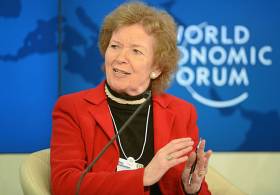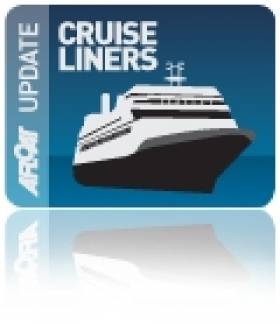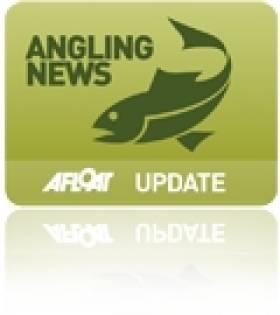Displaying items by tag: Mary Robinson
#OurOceanWealth - Former President of Ireland Mary Robinson has been confirmed as keynote speaker for this year’s Our Ocean Wealth Summit, taking place in Galway on Thursday 28 and Friday 29 June.
Now in its fifth year, the Our Ocean Wealth Summit forms a key part of the Government’s integrated marine plan Harnessing Our Ocean Wealth. The summit is a key event for the marine sector and related industries, offering a platform for discussion on the future of Ireland’s marine sector.
This year, the summit will extend across two days with a packed programme of presentations as well as panel discussion, interactive sessions and networking events.
Galway Docks will host the event, expected to attract more than 500 national and international delegates from across the marine sector.
The largest gathering of Ireland’s marine and business communities, the Our Ocean Wealth Summit attracts high-profile speakers from across the globe, not only from the marine sector but from a wide-range of disciplines.
This year’s keynote speaker is Mary Robinson, the seventh President of Ireland and the first woman to hold the office. In 2010 she established The Mary Robinson Foundation – Climate Justice, a centre for thought leadership, education and advocacy on the struggle to secure global justice for people vulnerable to the impacts of climate change.
Other key speakers will include former Nasa astronaut Kathryn Sullivan, who was appointed by US President Barack Obama as Under Secretary of Commerce for Oceans and Atmosphere, and National Oceanic and Atmospheric Association Administrator (NOAA). Sullivan has a long career as a distinguished scientist, astronaut and oceanographer.
Producer of BBC’s award-winning Blue Planet II series Orla Doherty is also one of the highlights of the summit programme. With family roots on the Donegal coast, Doherty has had a strong connection to the sea. She is an expert in underwater filming and has filmed scientists at the frontline of ocean discoveries from Indonesia to the Arctic Circle.
This year’s theme is ‘Investing in Marine Ireland’ and the summit will focus on progress towards the Government’s ambitious targets to double the value of the blue economy by 2030.
The diverse programme planned for this year’s Summit reflects strong collaboration between Bord Iascaigh Mhara, Bord Bia, Enterprise Ireland, IDA Ireland, Fáilte Ireland, Science Foundation Ireland, Marine Institute and the Sustainable Energy Authority Ireland, with individual sessions addressing environmental, economic and societal opportunities and challenges to creating a sustainable ocean economy for Ireland.
The Our Ocean World Summit coincides with Ireland’s national maritime festival, SeaFest 2018 in Galway from Friday 29 June till Sunday 1 July.
#FORMER IRISH PRESIDENT ON CRUISE – Former President of Ireland, Mary Robinson was a guest speaker on board the National Geographic Explorer during the first leg of a 14-day 'Exploring the British Isles and Irish Isles' cruise which departed the UK last week, writes Jehan Ashmore.
The theme of the lecture was about the perspective and context of 'modern' Ireland which formed part of the 'Global Perspective Programme' organised by the cruise operator Lindblad Expeditions.
Robinson who was also a former UN High Commissioner for Human Rights was also a guest speaker on the same vessel a year ago, where she shared her insights on what was then the recent historic visit of Queen Elizabeth II to Ireland.
The 148 passenger cruiseship is today on the start of an itinerary of the western Scottish Isles, having passed yesterday evening the 2,000-foot Slieve League, the highest sea-cliffs in Europe. The 6,471 tonnes vessel departed Killybegs from where her guests travelled to Glencolumbkille.
In addition she had anchored earlier in the morning between Inishmurray Island and Grange, Co. Sligo. The 228-acre island which has a 6th century monastery was inhabited until abandoned in 1948.
Since the cruise began in Portsmouth the vessel has called to several locations and the Irish west coast to the Skelligs, Dingle Peninsula, Kilronan on Inishmore of the Aran Islands and Cliffs of Moher.
It is to such destinations that are typically visited by Lindblad Expeditions in partnership with the National Geographic Society (NGS) which produces the renowned monthly magazine. At isolated and more inaccessible destinations passengers make shore excursions using Zodiac tenders.
In addition to hosting forums such as the Global Perspective Programme, the strategic alliance with NGS enables renowned experts from the society scientists, naturalists and photographers to accompany guests on visits to field sites that include those committed in sustainable geo-tourism.
National Geographic Explorer was built as Midnatsol in 1982 for Hurtigruten of the Norwegian Coastal Voyages. She is ice-strengthened and is the largest of the Lindblad fleet.
Several years ago the interiors were completely gutted-out in a Spanish dry-dock, resulting in an essentially different ship for her new role with many high-tech features and equipment incorporated. The most impressive being a remotely operated vehicle, or ROV, which can dive 1,000 feet below the ice.
National Disabled Angling Centre to Stay Open Pending Review
#ANGLING - The National Disabled Angling Facility at Aughrim in Co Wicklow is to remain open following an 11th-hour agreement last month, The Irish Times reports.
A deal reached between Fás, Siptu and the centre's staff will retain all 23 jobs with a 25% pay cut and see the premises stay open until a "review" is published in March.
Opened by then President Mary Robinson in 1996, the facility is operated as a Community Employment Fás scheme and has been an invaluable amenity for disabled anglers nationwide.































































